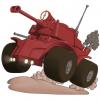The first step to any interactive game is a "game loop"... I guess its what you call time steps.
Inside this game loop, that runs for a set number of times per second (30 or 60 commonly in todays games -> Frames per second), you have multiple sub parts, for updating the game logic, getting user input, handling physics and collisions, and, of course drawing the graphics to the screen.
Depending on the game, this might be a very simple loop, or a very elaborate "engine" that your game logic runs in and that takes your graphics assets and sounds and does all the low level tasks for you.
Now, before I go too much into details you could read on websites or in books in much more detail than I have time to write here, let me tell you this:
If you have this little knowledge about game development, file away the game idea you have for now, and start MUCH smaller.
Learn the basics, and start creating pong, pacman, tetris clones.... games from the dawn of video games that combine very simple graphics with very simple game logic. Games that can be easely created in hours by more expierienced game developers, and should be able to be created in days by less expierienced ones.
Don't aim for the stars right now... you will just end up disappointed.
Because you mentioned Mortal Kombat: If you are trying to recreate the graphics style, be aware that Mortal Kombat was one of the Pre-Rendered 2D Games created in the mid nineties. That means, all objects and characters in the game where created in 3D on at the time extremly expensive Silicon Graphics Workstations, and the animation frames where rendered out to static 2D Sprites.
While 3D Gaphics has matured a lot since then, so you can create a similar pre-rendered style on any normal computer nowadays, you now additionally need to learn 3D Modelling. And while this stile CAN be much more scalable compared to traditional handdrawn 2D graphics, you have a much higher overhead. You need to create fully 3D Models, and then rig (prepare) them for animation, which can take a lot of time. Once ready, capturing animation frames can be much faster than the traditional way of redrawing every frame in 2D.
Still, for a beginner starting with simple drawn and handanimated 2D Sprites might be the less bumpy road at first.







